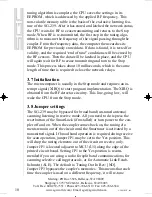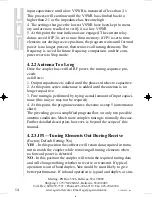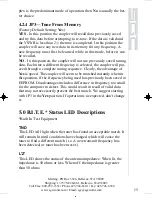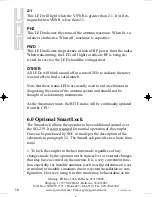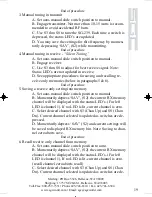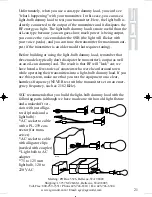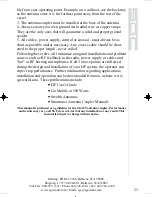
Mailing: PO Box 3526, Bellevue, WA 98009
Shipping: 13737 SE 26th St., Bellevue, WA 98005
Toll-Free: 800-259-7331 • Phone 425-746-6310 • Fax: 425-746-6384
www.sgcworld.com • Email: sgc@sgcworld.com
9
3.4 VSWR Detector
A directional coupler is made up of a current transformer T2 and a
voltage transformer T1, in conjunction with termination resistors R35,
R36 and R33, R34. The coupler is inserted in the 50-ohm transmis-
sion line between the input connector, ST2 RF - ST3 GND, and the
tuning network. The forward power is measured across termination
R33, R34 and reflected power is measured across termination R35,
R36. Diode D1 generates a positive DC voltage proportional to for-
ward power and D3 generates a positive DC voltage proportional to
reflected power. The forward DC output is fed to a voltage divider
consisting of R19 and R14. These voltages are input to the RF power
detector and to an A to D converter port of the processor. The re-
flected DC output passes through a voltage divider consisting of R29
and R16, and then it also goes to an A to D converter port of the proc-
essor.
3.5 Phase Detector
A phase detector is formed by T3, A1, and their associated compo-
nents. This detector indicates the state of any reactance associated
with the antenna coupler as noted from the generator. A line current
sample is compared in phase with a voltage sample in a double bal-
anced mixer. Output polarity varies negative or positive depending on
the reactance of the antenna. The output of the phase detector A1 is
shifted to a 0 to 5v range, then fed to the processor’s A to D converter
port and used within the micro controller.
3.6 Central Processing Unit (CPU)
A tune-up algorithm, which is contained in the memory of the micro-
processor, implements the antenna matching. It is designed around the
MC68HC711E9 CPU that features a versatile instruction set, RAM,
and EEPROM (memory which is saved after the coupler is turned
off). The antenna coupler relays are controlled by latches U6 and U7,
which receive serial data input directly from the CPU. During opera-
tion, data is transferred into the CPU from the A to D ports and Input
Capture port (measures RF frequency). Basically, the program moni-
tors the status of the input sensors and—starting from a preset condi-
tion—uses a built-in algorithm to achieve a tuned condition. When the
SG-239 Manual
page 9
Wednesday, October 17, 2001 08:31
Composite










